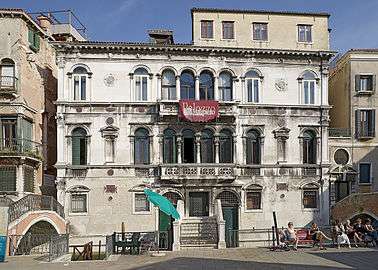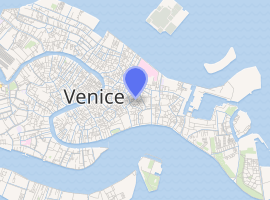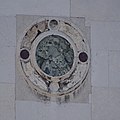Palazzo Malipiero-Trevisan
Palazzo Malipiero-Trevisan is a Renaissance palace in Venice, Italy located in the Castello district, on the south-eastern side of campo Santa Maria Formosa and separated from it by the Santa Maria Formosa river (entry is through a private bridge).[1][2]
| Palazzo Malipiero-Trevisan | |
|---|---|
 Palazzo Malipiero-Trevisan | |

| |
| General information | |
| Type | Residential |
| Architectural style | Renaissance |
| Address | Castello district |
| Town or city | Venice |
| Country | Italy |
| Coordinates | 45°26′12.5″N 12°20′29.6″E |
| Renovated | 15th-16th century |
| Technical details | |
| Floor count | 3 |
History
The palace was the residence of the Malipiero family until the end of the 15th century when it passed, by marriage, to the Trevisan family. Perhaps on this occasion it was rebuilt in its present form; the project was for a long time attributed, without certain proof, to Sante Lombardo who, more likely, was only concerned with finishing its decoration.[3] The palazzo was mentioned by Sansovino.
As time passed, the palazzo was divided in several properties, where the Diedo, the Bembo, and the Zen families lived, in addition to the Trevisans themselves. The building also hosted the famous Fracasso printing house. The palace is still divided into several apartments.
Architecture
The setting of the symmetrical façade, which still preserves the original Istrian stone roof, is typically of the Venetian Renaissance architectural style. The building consists of three floors: a ground floor and two noble floors. The ground floor has two round-arched portals on the river; two noble floors of the same layout are decorated with quadriforas at the center. The quadriforas are decorated with sculpted parapets and flanked by pairs of single-light windows.
To embellish and regulate the parts of the façade, there are niches and marble discs—the latter recalling the Gothic-Byzantine style typical for the nearby Palazzo Vitturi. Inside, on the second floor, there are frescoes painted in the 18th century, still in good condition. The whole look of the structure, however, is ruined by a modern addition on top.[4]
Gallery
 Private bridge to the palace
Private bridge to the palace_-_Foto_Giovanni_Dall'Orto%2C_6-Aug-2007.jpg) Facade details
Facade details Private bridge and central portal
Private bridge and central portal Marble disc on the facade
Marble disc on the facade
See also
References
- Honour, Hugh (1997). The Companion Guide to Venice. Companion Guides. p. 100. ISBN 9781900639248. Retrieved 1 September 2019.
- Huse, Norbert; Wolters, Wolfgang (1993). The Art of Renaissance Venice: Architecture, Sculpture, and Painting, 1460-1590. University of Chicago Press. p. 34. ISBN 9780226361093. Retrieved 1 September 2019.
- Douglas, Hugh A. (2012). Venice on Foot. Read Books Ltd. ISBN 9781447486091. Retrieved 1 September 2019.
- Shaw-Kennedy, Ronald (1978). Venice Rediscovered. Associated University Presse. p. 87. ISBN 9780845314845. Retrieved 1 September 2019.